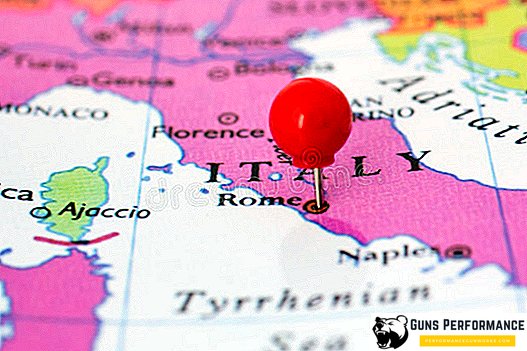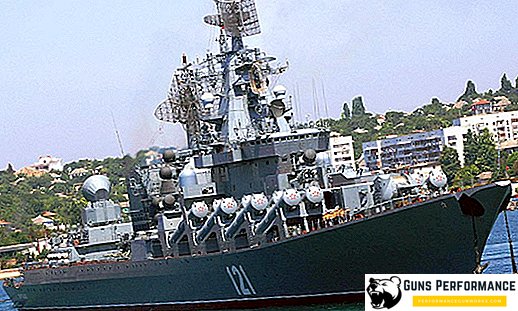
Despite its ancient history, Italy is a relatively young state. Today, the country is a model of the republican form of government, where all legislative and executive power is concentrated in the hands of elected bodies of state administration.
The political status of the Italian parliament is very high today. No less honorable and prestigious in Italy is the post of prime minister.
Historical excursion into the political life of the Italian state

In the XIX century, Europe entered the era of the people's democratic revolutions that shook the thousand-year monarchies. Against this background, national-liberation movements were gaining strength, which set as their goals the acquisition by the peoples of individual territories of their national identity and sovereignty. At that time, there were two centers of national and state uncertainty in Europe, in central Europe on the lands of numerous German states and in Italy.
In Germany, militarist Prussia was at the origins of the unification, which set a goal to unite all German states under its command. In Italy, the center of national attraction was the Sardinian kingdom, the only sustainable state entity in Italy. In fact, the entire territory of modern Italy in the middle of the 19th century was a collection of quasi-states, where every major city was the center of a regional public entity. Large areas of the country were under the control of the occupying forces of foreign countries, and the ancient capital of the country, Rome, was considered the patrimony of the papal throne.

The southern flavor and Italian temperament reflected on the character of the national liberation movement, which embraced all the Italian lands, which received the resounding name of the Risorgimento - literally "rebirth or renewal." The king of Sardinia, Carl Albert, tried to lead the armed struggle of the rebellious cities of Northern Italy against the Austrians, but this policy failed because of the weakness of the Sardinian army in the face of the military power of the Austrian Empire. Only later, when the royal troops and detachments of revolutionaries led by Giuseppe Garibaldi came out in front of one another, did the national liberation war acquire a different status and give its results. After Sardinian troops and revolutionary troops established control in Lombardy, in Tuscany, in Romagna and in Parma, the process of forming a unified state began. The result of a long armed and diplomatic struggle was the proclamation of the creation of the Kingdom of Italy on March 17, 1861 by the Sardinian parliament. The head of the new state automatically became the king of Sardinia and Piedmont, Victor Emmanuel II, who continued the Savoy dynasty on the Italian throne.

The first steps towards the establishment of a constitutional monarchy
It cannot be said that the young Italian state had to start building the state apparatus from scratch. The basis of the state machine of the Italian kingdom lay the Constitution of the Sardinian kingdom of 1848 - the Albert Statute, adopted by the predecessor of Victor Emmanuel, King Carl Albert.

The Kingdom of Sardinia has already had the experience of coexisting democratic institutions with a monarchical form of government. This was manifested not only in the adoption of the Constitution, which confers significant rights and freedoms, but also in the subsequent convocation of the first Sardinian parliament. The king was forced to transfer some of the most important areas of state administration into the hands of ministers headed by the chairman, Count Balbo. The entry of Carl Albert into the confrontation with the Austrians ended in military defeat. Under the influence of failures at the front and against the backdrop of grandiose diplomatic failures, all the activities of the executive power in the kingdom were paralyzed. The first Cabinet of Ministers, led by Balbo, resigned in July 1848.
The only government that managed to do anything in a difficult social and social situation was Cabinet of Joberty, which lasted until February 1849. A month later, it was the turn of King Charles Albert. In March 1849, under the pressure of a growing revolutionary movement, Carl Albert abdicated the throne in favor of his son Victor Emanuel. Having become a monarch, the new king quickly formed a new government of the kingdom, which was headed by the Marquis D᾿Adzello, which existed until October 1852. The basis of the entire policy of the new Cabinet was the work of Count Cavour, who gradually became the first powerful political figure of the kingdom.

Cavour served as chairman of the Council of Ministers of the Sardinian Kingdom for 7 years, from November 1852 to July 19, 1859. Among his merits is successful diplomatic activity, thanks to which the Austrians were driven out of the country, and the Italian territories that were under French occupation were returned. Thanks to the sequence of his actions, Cavour can be called the creator of united Italy with full confidence. At the peak of its popularity, Cavour in March 1861 became the Head of the first government of the Kingdom of Italy, but the death of the politician interrupted his brilliant career. After a serious illness on June 6, 1861, Earl Camillo Benso di Cavour, the first chairman of the Council of Ministers of the Italian Kingdom, died.
Leapfrog with Italian Prime Ministers in the 19th Century
Despite fairly strong political traditions, the young Italian kingdom was not distinguished by a stable internal political life. From the first days of accession to the throne, King Victor Emmanuel II headed for the monopolization of state power in the country. This was facilitated by the heterogeneity of the Italian parliament, in which, after the revolution and the war of liberation, a wide variety of political forces were represented. The ruling party of liberal conservatives and its opponents, the liberal and progressive party, which had a center-left position, enjoyed the greatest support of the people. After the death of the Chairman of the Council of Ministers of Cavour, the Italian government was headed by Betinno Ricasoli, representing the same political force as the previous First Minister.

From this moment begins the real Premiera - a period of Italian political history of eight years, from June 1861 to December 1868. During this time, the parliament was re-elected twice in the country, and the Council of Ministers was headed by seven prime ministers. The frequent change of government is due to the political instability in which Italy ended up after unification. After under the pressure of the king in Italy, the persecution of radicals and people with an active revolutionary past ceased, the state control system took certain shape.
Regular parliamentary elections in December 1869 brought to power the government of Giovanni Lanza, who led a coalition of right-wing forces. This government has managed to distinguish itself quite successfully in both domestic and foreign policy. The new Cabinet of Ministers appeared in the country only four years later, in July 1873.

In all, the Kingdom of Italy before the First World War had thirteen governments, which in turn were headed by representatives of right and left political forces. The governments headed by the following prime ministers performed most clearly on political Olympus:
- Giovanni Lanza, years of government 1869-73;
- Agostino Depratis was Italian Prime Minister three times, with short breaks, from 1876 to 1879 and from May 1881 to July 1887;
- Francesco Crispi, reign 1887-1891 and 1893-1896;
- Giovanni Giolitti served as prime minister of Italy three times: from November 1903 to March 1905, from May 1906 to December 1909 and in 1911-1914.
In the era of the Cabinet of Giovanni Giolitti Italy becomes a powerful industrial state and occupies one of the leading places in European politics. Despite the fact that the King of Italy, Victor Emmanuel II, in foreign policy, to the royal houses of the German Empire and Austria-Hungary, Italy entered the First World War on the side of the Entente. In the war years, depending on the situation at the front and on the overall foreign policy situation, the composition of the Cabinet of Ministers also changed. In total, over this period, three persons have served as prime minister: Antonio Salandra, Paolo Bosseli, and Vittorio Emanuele Orlando.

Italy in the era of Benito Mussolini
The Kingdom of Italy withdrew from the war in the status of the winner, but as a result of the peace conferences, the government of King Victor Emmanuel II did not receive major preferences. In the postwar years in Italy, against the background of a not very successful domestic policy, the fascist movement was rapidly gaining momentum. The leader of the Italian fascists becomes Benito Mussolini, whose policy is built on the denial of the achievements of the ruling liberal conservatives. On the internal political front, the struggle between radicals, socialists and fascist military alliances has intensified. The rapid rise of the fascists on the political Olympus of the Italian kingdom was promoted by the formation of the Italian Communist Party in 1921. In the same year, the fascist movement received the status of a political party, becoming the National Fascist Party.

The last democratically elected prime minister in Italy is Luigi Fakta, who led the Italian government throughout 1922 - a period of acute internal political crisis.
The Italian fascists, taking advantage of the weakness of the central government, made an attempt in 1922 to softly change the political regime. Under the guise of fighting the growing communist threat, the fascists set an ultimatum to the king of Italy, demanding that during this difficult period all power in the country be transferred to the representatives of the fascist movement. Acting contrary to the articles of the Albert Statute, King Victor Emmanuel II in October 1922 appointed Benito Mussolini as prime minister of the country.
With the coming to power of the fascists in the country, all the main institutions of state power, including the current parliament, remained de jure. In fact, all power in the Italian kingdom came under the control of the government of Benito Mussolini, establishing the dictatorship of one person.

The whole period of being in power, Benito Mussolini was a test period for Italy. A country that did not have a serious political weight in world politics, did not have a powerful economy, became for many long years hostage to the political ambitions of Benito Mussolini, who in 1925 received the honorary title of "Duce" - "leader." The power of the king in the country becomes nominal and has no political influence on the domestic and foreign policy of the state. The decrees and orders of the Prime Minister bear the force of state laws, enforcing the political will of the fascist party and its charismatic leader. Formally, Mussolini held the post of Italian Prime Minister, but in reality it was a real dictatorship, where orders and decrees of the “Duce” were often placed above the law. The Cabinet of Ministers was replaced by the Great Fascist Council, which assumed all the powers of the executive branch in the country.
Benito Mussolini reigned supreme until July 25, 1943. Italy, participating in the Second World War on the side of Nazi Germany, had by that time completely lost control over the military-political situation. The reckless and short-sighted policy of the "Duce" has led the country to the brink of a national and humanitarian catastrophe. In 1943, when the Allied forces landed in Sicily, by decision of the Great Fascist Council, the king removed Benito Mussolini from the leadership of the country and arrested. In the spring of 1945, while trying to flee the country, Benito Musolini was detained by an armed detachment of Italian patriots, and on April 28, the former dictator was executed by a sentence of the Freedom Volunteer Corps.

Premieres of the Italian Republic
The fall of the Mussolini regime and the occupation of the country, first by the Germans and then by the allied forces, placed Italy in a position of political time pressure. In the transition period from 1943 to July 10, 1946, the country was ruled by governments headed by Marshal Badoglio, Ivano Bonomi, Ferruccio Parry and Alcide de Gasperi, who became the last prime minister of royal Italy. Under pressure from the winning countries in 1946, a national referendum was held in Italy, as a result of which the country became a parliamentary republic.

Impressed by such fateful events, the King of Italy, Victor Emmanuel II, abdicated the throne on May 6, 1946 in favor of his son Umberto, who received the nickname "May King". A month later, the new king was deposed. As a result of the constitutional referendum, the monarchy in Italy ceased to exist.
In November 1947, Italy receives a new Constitution, in accordance with which all legislative power in the camp passes into the hands of a bicameral parliament. The Cabinet of Ministers becomes the highest executive body, whose head is formally appointed by the President of Italy, and in fact represents the party majority formed in parliament as a result of a nationwide vote. The head of the Cabinet is in charge of the entire sphere of executive power, starting with the management of relevant ministries and ending with the country's representation in the foreign policy arena. The Prime Minister and his ministers set for themselves goals and objectives reflecting the policies of the parliamentary majority. The powers of the prime minister in accordance with the new Basic Law include the right of legislative initiative, moreover, all presidential decisions and decrees now need to be endorsed by the Prime Minister.

Needless to say, the Constitution of the Italian Republic gives the prime minister of the country unlimited powers, unlike other parliamentary republics, where the head of the Cabinet cannot independently appoint and remove specialized ministers from the position. This explains the frequent change of government of Italy, which is replete with the political history of the country in the second half of the XX century.
With regard to political orientation, the state apparatus of Italy in the postwar years becomes the workplace of representatives of the Christian Democratic Party of Italy, formed in 1945 on the fragments of the liberal-conservative party.
Against the background of the general political and social crisis that broke out in the country in the 60s, the Italian government is under constant pressure from internal political forces. The instability of domestic politics turned out for Italy over the years of bloody political terror. The struggle of neo-fascist organizations with progressive socialists and communists was fatal for Prime Minister Aldo Moro, who was killed by terrorists in 1978. In 1977 alone, more than two thousand acts of political terrorism occurred in the country, the victims of which were politicians of various levels.

The most famous premieres of Italy
In total, for the period of existence of the Italian Republic, the government of the country was headed by 27 persons. It is possible to speak in different ways about the significance of a political figure in the history of the Italian state, but Italy holds the palm in the number of prime ministers in power.
The following prime ministers made a significant contribution to the economic and political development of Italy:
- Alcide de Gasperi led eight governments, taking the premiership from 1946 to 1953;
- Aldo Moro, years in office 1963-1968 and 1974-76;
- Silvio Berlusconi, who became the country's prime minister three times in 1994–95, in 2001–06, and also headed the Cabinet of Ministers in 2008–11.

Over the years of the existence of Italy as a unified state, from 1861 to the present day, the government of the country was headed by 56 people. Today, the Cabinet of Ministers is headed by the leader of the Democratic Party of Italy, Paolo Gentiloni, who was elected to this post in December 2018. Since the beginning of the 1990s, the political elite of Italy has been replenished with a number of new parties that have seriously pressed the position of the Christian Democrats. The last three prime ministers of Italy are the leaders of the Democrats, who received the support of voters through competent domestic policy.

Официальная резиденция нового премьер-министра Италии - дворец Палаццо Киджи, находящийся историческом центре Рима. Сегодня здесь сосредоточен аппарат премьера, находится приемная главы государства и ряд служебным структур правительства Италии.












